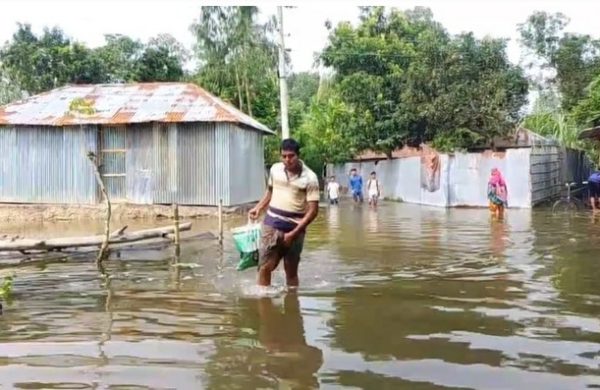WHO GLOBAL STATUS REPORT// Significant drop in drowning deaths in Bangladesh
- Update Time : Saturday, December 14, 2024

TDS Desk
Over the past two decades, drowning deaths in Bangladesh have significantly decreased, from 17 per 100,000 population in 2000 to six per 100,000 today. However, the rate remains much higher than the global average, according to a World Health Organization (WHO) report released yesterday.
Globally, the drowning death rate has fallen from 6.1 to 3.8 per 100,000 population since 2000, as noted in the WHO Global Status Report on Drowning Prevention, published yesterday. The report highlights a 38% reduction in the global drowning death rate over the past two decades—a notable public health achievement.
Despite this progress, WHO cautioned that drowning deaths remain a preventable public health crisis. The reductions achieved so far fall short of what is needed to meet the Sustainable Development Goals (SDGs) to which drowning prevention contributes.
Bangladesh remains one of the countries with the highest burden of drowning deaths. Although the reduction from 17 to six per 100,000 population represents significant progress, it still lags behind the global average. WHO recognizes this decline as an important step forward but emphasizes that more needs to be done.
Michael R Bloomberg, WHO Global Ambassador for Noncommunicable Diseases and Injuries, wrote in the report’s preface:
“Our work began in Bangladesh, where data showed that drowning was the leading cause of death among children aged 1–4. A lack of daytime supervision was putting children at risk, so we established and funded 2,500 community childcare sites. The results were extraordinary—drowning deaths fell by 88% among daycare-enrolled children, which captured the attention of the national government.”
In 2024, the Bangladesh government officially took over funding for the program, expanding its support to 8,000 community childcare sites and reaching 200,000 children annually.
This is the first WHO Global Status Report on Drowning Prevention, published 10 years after the landmark WHO Global Report on Drowning. The earlier report identified drowning as a preventable public health challenge that had received insufficient global attention or strategic prevention efforts.
Despite progress, the current trajectory remains inadequate to meet global targets. The WHO report warns:
“If we do not urgently strengthen our efforts to prevent drowning, current trends indicate that by 2050, over 7.2 million people, primarily children, could lose their lives to drowning.”
The report also highlights the ongoing severity of the issue, estimating that more than 30 people drown every hour, with 300,000 drowning deaths recorded in 2021 alone.
“The significant decline in drowning deaths since 2000 is encouraging and demonstrates that WHO’s
simple, practical interventions are effective,” said Dr Tedros Adhanom Ghebreyesus, WHO Director-General.
“However, every drowning death is one too many, and millions remain at risk. This report provides essential data for policymakers and offers urgent recommendations to save lives.”
CHILDREN AND YOUNG PEOPLE BEAR THE LARGEST BURDEN
Nearly half of all drowning deaths occur among individuals under the age of 29, with a quarter involving children under 5 years old. Children who lack adult supervision are at particularly high risk of drowning.
Children under 5 years old represent the largest proportion of drowning deaths (24%), followed by 19% among children aged 5–14 and 14% among young people aged 15–29.
Globally, drowning is the fourth leading cause of death among children aged 1–4 and the third leading cause of death among those aged 5–14.
PROGRESS IN REDUCING DROWNING UNEVEN
Globally, 9 out of 10 drowning deaths occur in low- and middle-income countries.
The WHO European Region experienced a 68% decrease in the drowning death rate between 2000 and 2021. In contrast, the WHO African Region, which has the highest drowning death rate of any region at 5.6 deaths per 100,000 people, saw a decline of only 3%. During the same period, the drowning death rate fell by 21% in the Eastern Mediterranean Region, 38% in both the Region of the Americas and the Western Pacific Region, and 48% in the South-East Asia Region.
“Drowning continues to be a major public health issue, but progress is possible, especially if governments collaborate with strong local partners,” said Michael R. Bloomberg, founder of Bloomberg LP and Bloomberg Philanthropies, WHO Global Ambassador for Noncommunicable Diseases and Injuries, and the 108th mayor of New York City.
“For more than a decade, Bloomberg Philanthropies has supported governments and local organizations leading effective drowning prevention efforts. This new report highlights what more countries can do to save thousands of lives each year.”
CLEAR GUIDANCE TO REDUCE DEATHS OUTLINED BUT UPTAKE VARIES
More than 7.2 million people, primarily children, could die from drowning by 2050 if current trends continue. However, most drowning deaths can be prevented by implementing WHO-recommended interventions.
WHO suggests a series of community-based actions for drowning prevention. These include installing barriers to restrict children’s access to water, providing safe areas away from water for preschool-aged children, and teaching school-aged children basic swimming, water safety, and safe rescue skills. Additional recommendations involve training individuals in rescue and resuscitation, raising public awareness about drowning prevention, establishing and enforcing safe boating, shipping, and ferry regulations, and improving flood risk management strategies.
The report emphasizes that WHO’s evidence-based drowning prevention measures are being implemented to varying extents worldwide. Encouragingly, 73% of countries have search and rescue services, and an equal percentage implement community-based flood risk mitigation programs. However, only 33% of countries offer national programs to train bystanders in safe rescue and resuscitation, and just 22% integrate swimming and water safety training into school curricula.
Accurate data collection is essential for developing effective prevention strategies. Yet, only 65% of countries report gathering drowning data through civil registration and vital statistics systems. High-quality data is further required to raise awareness, mobilize governments, and encourage communities to take meaningful action.
STRENGTHS AND SHORTFALLS IN POLICY AND LEGISLATION
While 81% of countries have laws addressing passenger safety for boat travel, only 44% of these laws mandate regular safety inspections of boats. Furthermore, just 66% of countries require the use of lifejackets for recreational boating and water transport.
Notably, 86% of countries lack legislation requiring fencing around swimming pools, a crucial measure for preventing child drownings in specific settings.
Michael R Bloomberg, founder of Bloomberg LP and Bloomberg Philanthropies, has served as the WHO Global Ambassador for Noncommunicable Diseases and Injuries since 2016. Bloomberg Philanthropies has made significant investments in public health, including US$ 1.58 billion to reduce tobacco use and youth e-cigarette consumption, support healthy food policies, and improve road safety and maternal health, among other initiatives.
In May 2024, Bloomberg Philanthropies announced an additional US$ 60 million investment to prevent drowning deaths in Bangladesh, Ghana, India, Uganda, the United States, and Vietnam. This brings Bloomberg Philanthropies’ total global investment in drowning prevention to US$ 104 million.















